Published date
Related Collections from the Archive
From the book: Book 5: People, Places and Apartheid commissioned by The Department of Education
The1950s and 1960s in South Africa were marked by the apartheid state's tight control over the political, economic and social structures of the country. In contrast, the 1970s was a period during which the apartheid state began to show clear signs of weakness and disintegration. The nature and scale of the resistance during those two periods were quite different. The re-emergence of resistance politics during the early 1970s reflected a fundamental crisis in South African society. This crisis was both economic and political in its origins. Some characteristics of the crisis were:
- Very little or no economic growth took place towards the end of the decade.
- The administration and management of the complex network of apartheid laws was proving costly and had a negative effect on both white and black South Africans.
- The shortage of skilled labour, which was needed to run private industry and the state bureaucracy, had a negative economic impact.
- There were signs that Verwoerd’s ideology of allowing black Africans to “develop along their own lines in their own areas” had failed in South Africa.
- No foreign government recognised the independence of the homelands.
Given these factors, the government began to experience opposition from both black and white constituencies on a scale never seen before in South Africa. As workers and consumers, black people were developing economic and political power. Their children had come to hate the minority apartheid regime and its all institutions, and regarded the state as illegitimate. They were also openly defiant; refusing to be deferential towards whites, as was expected under apartheid. Afrikaner solidarity was also being challenged.
Among enlightened Afrikaners, members of the clergy, intellectuals and several Afrikaner business leaders began to see apartheid as both immoral and inefficient, and were striving for substantial changes.
At this stage, key political organisations in South Africa ”” namely the African National Congress (ANC), the South African Communist Party (SACP) and the Pan Africanist Congress (PAC) ”” were banned. Most of their leaders went into exile or were imprisoned. It was necessary, therefore, that challenges to the apartheid state should come from an entirely new set of forces.
homelands ”” those territories reserved for black people and around which the principle of segregation in South Africa was organised; sometimes called bantustans
The homeland system was made up of ten ethnic areas. Four of these eventually became “independent”. They were sometimes known as the TBVC states ”” Transkei, Bophuthatswana, Venda, Ciskei. The other six were referred to as “non-independent black states”. They were Gazankulu, KaNgwane, KwaNdebele, KwaZulu, Lebowa and QwaQwa.
How did labour challenge the apartheid state in the 1970s?
One such challenge came from black labour. It was becoming increasingly obvious that the job reservation laws, which reserved skilled jobs for white people, had a negative impact on economic growth and development. Black workers themselves became increasingly dissatisfied with the restrictions on their rights and their functions as workers, and started to challenge these restrictions. The wave of strikes in Durban at the beginning of 1973 and the strikes that took place afterwards throughout the country, reflected a
growing spirit of assertiveness among black workers.
This series of strikes marked a decisive turning point, not only in the history of South African labour relations, but in the history of South African society as a whole. Black workers showed that their interests, identities and functions as workers could no longer be defined for them by the state and their employers. The official formation in 1979 of the new trade union movement ”” the Federation of South African Trade Unions (FOSATU) ”” continued to put pressure on the state to change labour laws in line with the more advanced industrial economies in other parts of the world.
How did developments in Africa and foreign relations challenge the apartheid state?
From a regional and international perspective, the white government’s position in the 1970s was unstable. The collapse of Portuguese colonialism in 1974 meant that Mozambique and Angola could no longer act as buffers between “white” South Africa and the countries of independent black Africa.
Psychologically, the collapse of Portuguese rule in neighbouring countries was very important for black South Africans because it gave them hope ofsimilar change in their own country.
With the promise of military assistance from the United States, South Africa invaded Angola in 1975 in an attempt to destroy the control of the MPLA. The action resulted in a defeat for the apartheid forces and a psychological victory for many of South Africa’s oppressed people. During this period, wars for independence were being waged by freedom fighters in what was to become Zimbabwe and Namibia. These wars caused a continual drain on South Africa’s economic and military strength, while at the same time serving as an inspiration to blacks and others in South Africa seeking an end to apartheid rule.
The South African government faced increasing domestic resistance, an increasingly hostile international community and an arms embargoimposed by the United Nations in 1977. The government had the impossible task of finding a formula to defuse these threats while at the same time maintaining the economic and political foundations of apartheid.
Many African countries played a part in defeating apartheid by serving as sanctuaries to South African liberation fighters, trainee militants and exiled leaders. In many cases, this was in spite of South Africa’s economic and military superiority, which was used by the apartheid government to discourage neighbouring countries from pursuing anti-apartheid activities and lending support to South African exiles. Tanzania, which was the site of several military training camps for South African trainees as well as a nonmilitary
school for ANC refugee children, was an important focus of exile activity. The Tanzanian government was one of the most important African supporters of South African anti-apartheid organisations.
How did the youth challenge the apartheid state?
One of the most critical turning points of political resistance during the 1970s was the uprising that began on 16 June 1976. Police opened fire on youths protesting against apartheid education. Some historians argue that this was one of the most important events in the history of resistance in South Africa, and that many of the events and tactics employed in the resistance of the 1980s had their roots in the Soweto uprising.
The first shot fired on June 16 was “the single most important moment in South African history” because it “killed the dream of grand apartheid”. It “inspired blacks countrywide, motivated workers, boosted liberation movements, forever changed the perceptions of white South Africa and sowed panic in Afrikaner ranks that would place them on the defensive”¦.”
Source: Pat Hopkins and Helen Grange, The Rocky Rioter Teargas Show: The Inside Story of the 1976 Soweto Uprising. Cape Town, Zebra, 2001 (Introduction).
In South Africa, a campaign based on black consciousnesswas in the 1960s with the aim of fighting apartheid. Some BC-inspired organisations included the South African Students Organisation (SASO), which was set up to counter the multi-racial but whitedominated National Union of South African Students (NUSAS). Among school learners, the South African Students’ Movement was formed. The Black People’s Convention (BPC), a political party of which Steve Biko was honorary president at the time of his death in 1977 and which promoted BC ideas, was also established.
black consciousness”””” a political movement and ideology seeking to unite black people in affirming their common identity
The events of June 16 formed part of a much broader struggle. Within days of the Soweto protest, the uprising spread to black townships throughout South Africa. In the months that followed ”” a period collectively known as “the Uprisings of 1976” ”” thousands of protesters were killed by police, others were jailed, and still others left the country to join the ANC’s armed wing, Umkhonto we Sizwe (MK), and other exiled organisations.
How did black consciousness challenge the apartheid state?
One of the principal factors explaining the new assertiveness of black youth during the uprisings and throughout the decade was the growth of the ideology of black consciousness (BC). This political and philosophical movement attracted mainly black youth, priests and the adult intelligentsia.
The black consciousness philosophy found its expression in many different groupings rather than in a single organisation. Its origins can be traced to the launch of the University Christian Movement in the late 1960s and to the development of so-called Black Theology.
Black consciousness encouraged the psychological liberation of black South Africans who had developed feelings of inferiority as a result of their marginalisation at the hands of white people. This sense of inferiority was worsened by the fact that black people had no control over the social, political or economic institutions of the country despite their majority status.
Black people were also regarded as second-class citizens, and were subjected to inferior “Bantu Education”, which ensured that their economic and career prospects were severely limited.
Black consciousness helped black people to reassert a positive selfawareness, a pride in black culture, history and achievements. As a starting point for political liberation, the ideology of black consciousness also attempted to encourage blacks away from dependence on whites, particularly those “liberals” who claimed to be sympathetic to the black person’s plight but who benefited directly from apartheid by virtue of being white.
Photographer Peter Magubane describes the importane of June 16 in this way:
“One child was killed and South Africa was never the same. It exposed the cracks in the wall of apartheid. Without ’76, without the courage of those schoolchildren, we wouldn’t be where we are today.”
Source: Pat Hopkins and H.elen Grange, The Rocky Rioter Teargas Show: The Inside Story of the 1976 Somewto Uprising. Cape Town, Zebra, 2001, p.193.
embargo”” an official ban, especially on trade or other commercial activity with a particular country
intelligentsia”” an intellectual and well-educated elite within a particular social group, regarded as possessing culture and political influence
Who were some of the people who helped to shape the liberation struggle?
Stephen Bantu Biko
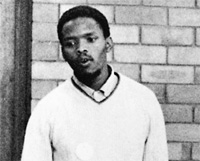 Stephen Bantu Biko, killed in police custody in September 1977, aged 30© Daily Dispatch
Stephen Bantu Biko, killed in police custody in September 1977, aged 30© Daily Dispatch
In recounting the story of opposition to apartheid, there is the danger of omission. So many remarkable, brave and selfless people were involved. This chapter is confined to accounts of some of the important figures whose distinctive contributions shaped the nature of this multi-stranded opposition.
Stephen Bantu Biko was a leading figure in the black consciousness movement. He was killed in police custody in September 1977, aged 30.
While a student at the Medical School at the University of Natal in the late 1960s, Biko recognised that a new psychological outlook was needed if the liberation of black people was to be truly effective. Biko understood and expressed the importance of identity in personal and political liberation.
Furthermore, he identified the way in which many blacks co-operated with the oppressor in their own oppression and objected to what he saw as black people “bearing the yoke of oppression with sheepish timidity”. In 1968, as a 22-year-old student, Biko left the white-controlled National Union of South African Students (NUSAS); the following year he formed the exclusively black South African Students Organisation (SASO) and became its first president.
Following expulsion from the Medical School, Biko joined the staff of the Black Community Programmes in Durban in 1972. The programme aimed to develop among the black community skills such as empowerment, decision making and critical thinking; it also wanted to implement practical programmes to meet the needs of the black community. In March 1973, Biko was served with banning ordersand was confined to his mother’s house in King William’s Town. From there he continued, despite his banning orders, to participate in and initiate black consciousness projects.
In 1976, during the SASO-BPC trial, Biko was given an opportunity to publicly articulate the principles of black consciousness. One month later, the Soweto uprising took place. Although Biko believed that no specific organisation could claim direct responsibility for the uprising, there was general agreement at the time that the black consciousness philosophy had given many young people the courage needed to take on the apartheid state. At the end of 1976, Biko spent 101 days in prison, much of it in solitary confinement. In August the following year, Biko was arrested. He died in September while still in police custody.
Steve Biko will be remembered as the father of the black consciousness movement. This movement recognised the potential for the growth of an identity for the oppressed. It inspired the culture of fearlessness and resistance that was to characterise the decade before Nelson Mandela’s release in 1990.
banning order ”” a document issued in terms of South African security legislation by which a person’s freedom of movement, association, speech and action were restricted
A banning order could restrict a person to a particular house or area. Sometimes, the banned person was restricted to his or her home and place of work. Sometimes, as in Biko’s case, it restricted the person only to the home. Sometimes it specified the number of people that the banned person could meet or speak to at one time. Some banned people could only be in the presence of one other person at the same time. This was an attempt on the part of the apartheid government to stop political activists from doing more damage to the state.
Richard Turner
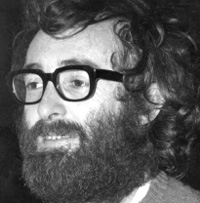 Rick Turner, a lecturer at the University of Natal, was banned in 1973 and assassinated in 1978.© Natal Witness
Rick Turner, a lecturer at the University of Natal, was banned in 1973 and assassinated in 1978.© Natal Witness
Radical resistance was not confined to the black consciousness movement. Among white South Africans, a major young radical thinker appeared on the stage. This was Richard Turner, who played an important role in helping to organise radical white student protest and black worker activity. Turner was trained at the University of Paris as a philosopher, and lectured in political science at the University of Natal. He posed a formidable challenge both to the state and to the more complacent ”” even if supposedly liberal ”” members of white society. His book, The Eye of the Needle, presented a provocative, readable and deliberately utopianvision of participatory democracy for South Africa. Turner was banned in 1973 and was prevented from teaching and preparing material for publication. Despite this, he wrote substantial studies in philosophy which were circulated among friends as underground writings. He gave expert evidence for the defence in the SASO-BPC trial.
In January 1978, Rick Turner was assassinated. Shortly before, he had been awarded a prestigious Humboldt scholarship to continue his academic work in Germany. The then Minister of Justice, Jimmy Kruger, would not allow him to take up this scholarship, and told the German ambassador that Turner was the most dangerous man in South Africa.
Father Trevor Huddleston
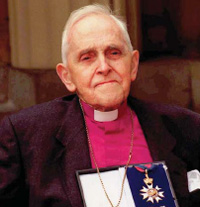 Veteran anti-apartheid campaigner, rchbishop Trevor Huddleston.
Veteran anti-apartheid campaigner, rchbishop Trevor Huddleston.
Whereas Biko and Turner ”” both murdered by the state ”” were active on the domestic scene, others were active abroad. These included not only the exiled leaders of the banned organisations that were referred to earlier. They also included key activists in the Anti-Apartheid Movement (AAM). Among the most important of these was Father Trevor Huddleston. He had arrived in South Africa from England in 1943 to serve as Priest-in-Charge of the Sophiatown and Orlando Anglican Mission in Johannesburg. In 1949 Huddleston was appointed Provincial of the Community of the Resurrection in South Africa and Superintendent of St Peter’s School. During this period, he became active in the struggle against apartheid and formed close friendships with leaders such as Oliver Tambo and Nelson Mandela.
In 1961 Huddleston was elected vice-president of the Anti-Apartheid Movement, a post he held until April 1981, when he became its president.
At the founding meeting of the movement in London, Huddleston endorsed an international appeal by then president of the ANC, Albert Luthuli, for a boycott of South Africa. When the AAM was disbanded after the end of apartheid, Huddleston became a founding Patron of the organisation that took the place of the movement, Action for Southern Africa. He continued to take an interest in South Africa until his death in 1998.
Other leaders of the liberation struggle
Towering above the oppositional leaders were, of course, the leaders imprisoned on Robben Island. The most famous of these was Nelson Mandela, whose 27-year-long imprisonment served as a rallying point for anti-apartheid activists around the world. His pragmatic, principled political morality ”” seen in his firm refusals to accept anything but unconditional release ”” served not only as a role model for the leadership that was not in prison, but also served, particularly towards the end of apartheid, as a source of reassurance for those who feared democracy.
There were many others who were also paradigmaticfigures. Most notable among these were Robert Sobukwe, founding president of the Pan Africanist Congress, and Chris Hani, best known as a leader of the South African Communist Party and Umkhonto we Sizwe.© Tony Harris / Associated Press
utopian ”” idealistic. This adjective comes from Utopia, an imagined perfect place or state of things. It was the name of a book by the sixteenth century author and philosopher, Thomas More.
paradigm”” a typical example, pattern or model of something
paradigm shift ”” a fundamental change in approach or underlying assumptions
paradigmatic figure”” someone who develops or represents a fundamental change in position
Part of Sobukwe’s legacy to South Africans is his teaching that, “There is only one race to which we all belong, and that is the human race”.
Source: Harriet Deacon (ed.), The Island:A History of Robben Island, 1488-1990.
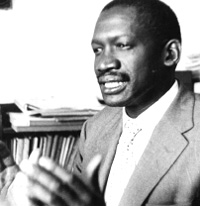 Robert Mangaliso Sobukwe, leader of the Pan Africanist Congress, May 1959.© Drum Photographer 1959 / Bailey’s African History Archive
Robert Mangaliso Sobukwe, leader of the Pan Africanist Congress, May 1959.© Drum Photographer 1959 / Bailey’s African History Archive
In 1958, Sobukwe and others left the ANC. This resulted in 1959 in the birth of the PAC, an organisation which sought the establishment of an “Africanist socialist democracy.” The PAC differed from the ANC in its refusal to accept any white leadership. It stood for a complete overthrow of the apartheid system, not equality and powersharing between its proponents and what it called “true” Africans.
Sobukwe’s politics were Africanist, but not racist. Sobukwe defined Africans” not by the colour of their skin but by their commitment to Africa. Martin Thembisile Chris Hani was one of the most popular leaders of the ANC, particularly among the poorest communities. Before his assassination by right-wing extremists, he was known as a tireless and fearless organiser of the ANC underground, a ommunist and a leader of Umkhonto we Sizwe.
After joining MK, Hani left South Africa in 1962 and spent time in Zimbabwe (then Rhodesia), where he served as Political Commissar. Together with cadres of the Zimbabwe African People’s Union (ZAPU), he fought against the Rhodesian government. After escaping to Botswana, he went to Zambia and re-entered South Africa in 1973. He was based for a time in Lesotho, where he operated underground and contributed to the building of the ANC.
After several assassination attempts on his life, Hani returned to Zambia in 1982. In 1987 he became Chief of Staff of MK at a time when that organisation was intensifying its struggle against the nationalist government.
The armed struggle is widely credited as being one of the factors that brought about the end of the apartheid system.
Chris Hani’s assassination in April 1993 nearly resulted in widespread violence and an end to negotiations. However, the appeal for calm by Nelson Mandela helped to save the situation. Hani’s death resulted in a stronger determination to work for a transformed South Africa.
What is the political culture of reconciliation and“transcendence”?
One of the notable features of South Africa’s political transition has been “forgiveness” and the remarkable absence of recrimination. Nelson Mandela has, of course, come to represent this “big-spiritedness” on the global stage, perhaps more than any other statesman since Mahatma Gandhi. Yet it in no way detracts from Mandela’s greatness to note that there existed a strong tendency within South African political culture to reach out and to forge understandings across seemingly unbridgeable divisions.
This syncretism, or bringing together of various viewpoints and beliefs, is an important part of South Africa’s political history. It is illustrated, in part, by the activities of organisations such as the mainstream churches and the South African Communist Party, with their emphasis on personal identities that, for all their rich diversity, are also “universal”.
This spirit of reconciliation and transcendencecame to mark the character of both those who worked for change within the conventional political structures, such as political organisations and even Parliament, and those who worked within the broad domain of civil society, including the churches. The names of Nelson Mandela and Desmond Tutu, former Anglican Archbishop of Cape Town, come to mind, as do those of Beyers Naude who was General Secretary of the South African Council of Churches (SACC), Frederick Van Zyl Slabbert, and even F.W. de Klerk, former state president. This approach is also to be found in the views of those who appeared to be more narrow in their political roots and convictions. For example, it is apparent in Biko and in Turner. It is also apparent in Sobukwe.
Attempts [by the government to retain power] included efforts to:
- ”¢ neutralise South Africa’s neighbours,
- Ӣ scrap apartheid symbols and practices that were not essential to the maintenance of white supremacy,
- Ӣ draw English-speaking South Africans into the party,
- Ӣ win the co-operation of big business,
- Ӣ intensify the ethnic and class cleavages among the subject people, and
- Ӣ suppress domestic dissidents.
Source: Leonard Thompson. A History of South Africa. New Haven, Yale University Press, 1990, p.224.
recrimination ”” an accusation in response to being accused by someone else; people blaming each other for something that went wrong
transcendence”” rising above or going beyond normal human experience
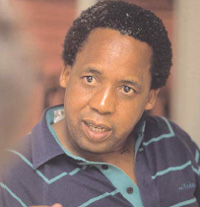 Martin Thembisile Chris Hani, a leader of the SACP and Umkhonto we Sizwe. © Tim Zielenbach
Martin Thembisile Chris Hani, a leader of the SACP and Umkhonto we Sizwe. © Tim Zielenbach
Other contributions towards reconciliation and transcendence were made by mediating institutions such as the Institute for a Democratic South Africa (IDASA). These organisations brought together diverse interests and people ”” both political and economic. They provided a framework within which elements of an entirely new political dispensation and agenda could be explored and articulated. They encouraged networking arrangements, which enabled progressive, disenchanted or purely pragmatic elements of the old social, political and economic elites to engage with those who were to become members of the post-transition elites. These institutions encouraged a broadening of horizons among participants and contributed to the syncretic character of South African politics.
What was the role of the United Democratic Front in the liberation process?
After the Soweto uprisings, a protest culture continued to spread through the black population of South Africa. In addition, an increasing number of young white people started to identify with the struggle against apartheid. In August 1983, a thousand delegates of all races, representing 575 organisations ”” trade unions, sporting bodies, community groups, and women’s and youth organisations ”” founded the United Democratic Front (UDF) to co-ordinate internal opposition to apartheid.
The UDF had an affiliated membership of over two million people, spanning all races and classes. The years following its establishment were marked by vigorous resistance to apartheid in all South African cities and homelands. Resistance took the form of school and bus boycotts, protests around increased rentals, mining strikes, incidents of sabotage against state assets, worker stayaways, clashes between township residents and security forces, and attacks on black police and councillors.
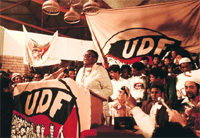 Frances Baard at the launch of the UDF in Cape Town 1983.© Paul Weinberg / South Photographs
Frances Baard at the launch of the UDF in Cape Town 1983.© Paul Weinberg / South Photographs
The UDF did not form itself into a political party because it did not want to compete with the ANC, which had gained much prestige during the 1980s. The ANC’s policies, embodied in the 1955 Freedom Charter, were greatly respected by the UDF. In fact, most UDF supporters regarded the ANC as the future government of South Africa and the imprisoned Nelson Mandela as the country’s future president.
How did the state try to “manage” the resistance?
Despite the importance of the uprisings of the 1970s, it is the 1980s that will go down in history as being the mostvolatiledecade in recent South African history. In 1978, P.W. Botha succeeded John Vorster as prime minister, and the National Party embarked upon an attempt to contain the resistance, but without giving up white control. It tried to do this in various ways (see box on page 24).
volatile”” likely to change rapidly and unexpectedly
The Wiehahn Commission
Its official name was the Commission of Enquiry into Labour Legislation. It was appointed in 1977 to look into problems associated with growing industrial conflict and job reservation. Existing legislation prevented the registration of African trade unions and made strikes by Africans illegal. Also, job reservations laws reserved certain jobs for white workers.
The major recommendations of the 1979 report of the Commission were:
- Ӣ African workers should be allowed to register trade unions and participate in the Industrial Council system.
- Ӣ Workers of all races should be allowed to belong to the same unions.
- Ӣ All legal job reservation should be abolished.
Source: John Pampallis, Foundations of the New South Africa,. Cape Town, Maskew Miller Longman, 1991, p.268. The Riekert CommissionDr Piet Riekert was appointed to investigate how manpower should be used.
“[The Riekert Commission] recommended more freedom of movement and choice of workplace for Africans ”” which led eventually to the government’s decision to abolish the Pass laws, arguably the single most important reform undertaken by P.W. Botha’s administration.”
Source: Reader’s Digest, Illustrated History of South Africa: The Real Story. Cape Town, Reader’s Digest, p.455.
Labour reform
One important effort at containment on the part of the government concerned labour relations. It was a response to the industrial strikes that had taken place since 1973 and to the need of manufacturing industry for a more passive and obedient labour force. During 1979, Parliament passed a law which gave effect to the recommendations of a commission chaired by Professor N. Wiehahn. The intention was to bring all African workers under control through legislation. Job reservation was officially abolished and all trade unions, including black trade unions, had to be registered. In the same year the recommendations of the Riekert Commission were also translated into law, signalling the end of the pass laws.
By 1986, African trade union membership was divided between two national federations ”” the Congress of South African Trade Unions (COSATU) and the Council of Unions of South Africa-Azanian Confederation of Trade Unions (CUSA-AZACTU). The latter had a black consciousness philosophy. Wage increase demands were generally successful. The unions gave blacks experience in democratic organisation and became important sources of worker power. Both federations were politically militant and became a central force in the struggle for power in South Africa. In effect, the government’s intention to control the black trade unions by legalising them had failed.
Constitutional reform
The second major change was constitutional. A new constitution came into effect in 1984. It formed a new Parliament made up of three chambers ”” a House of Assembly made up of 178 white representatives, a House of Representatives made up of 85 coloured representatives, and a House of Delegates made up of 45 Indian representatives. A multi-racial cabinet drawn from the three chambers was responsible for “general affairs”, while uniracial ministers’ councils were responsible for “own affairs”. The latter included areas such as education, health and local government. Despite the government’s moves to include coloureds and Indians, whites continued to dominate the new system. Africans, comprising 75% of South Africa’s population, were denied any representation in the new system.
Other reforms
Accepting that the homelands could no longer contain or support their populations, the government repealed the pass law and eliminated some of the segregation laws. By June 1986 the government had also repealed the bans on multiracial political parties and inter-racial sex and marriage, and had stopped reserving jobs for whites. It had opened up business centres in the cities to black traders and had desegregated some hotels, restaurants, trains, buses and public facilities. Sports contests could take place between teams of different races.
School education, however, remained strongly segregated. In 1986, the government was still spending more than seven times as much to educate a white child as it spent to educate an African child. There were similar inequalities in health and welfare services. Forced removals, detentions without trial and widespread repression through state organs such as the police and military also continued.
How did the state’s “emergency tactics” influence events?
Left with few options to contain the ongoing unrest in the country, the government imposed a countrywide State of Emergency in 1986. This was a desperate attempt to re-establish control over the country, particularly the African townships. The emergency regulations gave every police officer broad powers of arrest, detention and interrogation without a warrant. They empowered the police commissioner to ban meetings and prohibited all coverage of unrest by the media. During 1987, the government banned more than 30 organisations including the UDF and the Azanian People’s Organisation (AZAPO), and curtailedthe activities of COSATU. Despite vague promises of domestic reform, State President Botha made it clear in 1988, while addressing the National Party's annual congress in Durban, that majority rule was not on his agenda.
Meanwhile, the government’s piecemeal reforms were seen as too slow by the left and too liberal by the white right. They evokeda political backlash among white bureaucrats who lived by administering apartheid, semi-skilled workers threatened by black competition, and by ideologueswho saw things in simple racist terms. Right-wing parties, such as the Conservative Party led by Andries Treurnicht, the Herstigte Nasionale Party (HNP) and the Afrikaner Weerstands Beweging (AWB) succeeded in cutting into the government’s majority in by-elections. It was clear that there was no racial solidarity among the country’s whites.
The government’s problems were made worse by the growing recognition that apartheid was hindering the growth of the South African economy. In 1987, World Bank figures showed that South Africa’s growth rate was among the worst in the world. The unemployment rate was rising dangerously. White liberals, speaking through key figures such as Helen Suzman, started to express their discontent. An attempt was made to extend the power of this group through the formal political party system during the 1970s and 1980s.
Conclusion
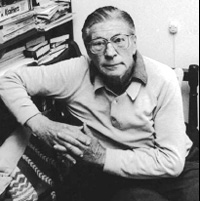 Dr Beyers Naude a tireless campaigner against apartheid © Paul Weinberg / South Photographs
Dr Beyers Naude a tireless campaigner against apartheid © Paul Weinberg / South Photographs
Generally, the 1970s and 1980s saw the emergence of civil society as a force to oppose the state. An important component of this civil society was the church. Since most anti-apartheid leaders were in exile, in prison or banned, clergy were thrust into the forefront of the struggle. Leaders such as Anglican Archbishop Desmond Tutu, Allan Boesak (moderator of the Dutch Reformed Mission Church and president of the World Alliance of Reformed Churches), Beyers Naude and his successor at the SACC, Frank Chikane, all took an active stand against the government and encouraged their constituencies to do the same. Deputations of reform-minded clergy, businessmen, intellectuals and sports administrators held talks with the ANC in exile and expressed support for a negotiated settlement.
A crisis of governance arose, resulting in the ousting in 1989 of P.W. Botha and his replacement by F.W. de Klerk as state president. De Klerk declared his intention to make fundamental reforms. During October of that year, he released eight political prisoners who had been serving life sentences since the 1960s. One of these was ANC stalwart, Walter Sisulu.
Although De Klerk’s initial intention was to maintain white ascendancy in South Africa by using group rights to protect the minority white population, it very soon became clear that a majoritarianstate was a likely outcome.
It is argued by Raphael de Kadt that the complete collapse of apartheid was evident in the outcome of the last racially exclusive Tricameral election held on 6 September 1989. The results, according to De Kadt, were obvious:
the increasingly hard-pressed white middle-class electorate ”” especially in the larger cities ”” had effectively abandoned the apartheid project.
The elections in September 1989 were seen by many for what they were:
the last racially-segregated elections to take place in South Africa and the beginning of the end of white rule. Some form of political settlement was needed.
Source: R. de Kadt, From Apartheid to Democracy: Logics of Dissolution, Patterns of Continuity. In Gustavo Mejia (ed.), Democracy and Human Rights in African-Hispanic Encounters: Transitions and Development. New Orleans, University of the South Press, 2001.
The leap from the elections of September 1989 to 2 February 1990, when Nelson Mandela was released was, therefore, a short one for De Klerk to make. It was clear by 1989 that the apartheid enterprise had reached its end, that the logic of the political settlement was in place. The release of Nelson Mandela was widely anticipated. The collapse of communism at the end of the 1980s assisted in easing F.W. de Klerk’s path towards unbanning all political parties. That move opened the door to negotiations about a totally new, non-racial democratic dispensation. It opened the door to a“New South Africa”.
curtail”” reduce in extent or quantity
evoke”” draw forth or call out
ideologue”” a dogmatic or uncompromising adherent of an ideology
majoritarian”” government by decisions of the majority